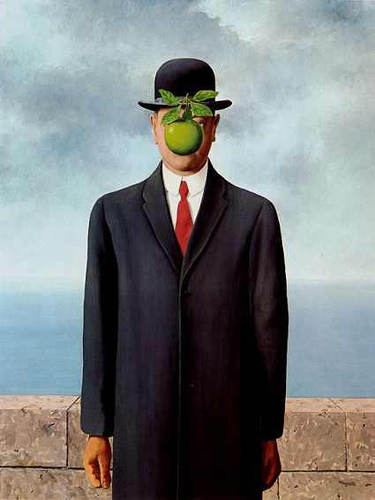In 1926, Max Ernst created the “The Blessed Virgin Chastises the Infant Jesus Before Three Witnesses: A.B., P.E. and the Artist,”. In the oil painting it depicts a a muscular Virgin spanking the infant Jesus, while Breton, Éluard and Ernst look on. At Max Ernst first showing of the piece, viewers found this large picture scandalous. It was denounced by Ernst’s own father and the archbishop of Cologne, who had the exhibition in which it was shown closed down. Today, this “blasphemous narrative,” says Rewald, is among the “icons of Surrealism.”
Ernst places Mary as a large figure towering over the baby Jesus. This is very usual to Mary/Jesus paintings as we normally see the baby Jesus in Mary's lap. Mary is also un-proportional to the rest of the painting. The trait derived from Mid-Evil art also magnifies Mary's importance. Also an interesting attributes of Mary in the painting is she still retained her halo even after spanking young Jesus. This means that she is still pure and holy and has not lost her holiness due to her actions.
Jesus is also un-proportional to Mary as he is not depicted as a baby, but as a young child around the ages of 8-10. Unlike Mary, Jesus does not retain his cross as the actions, which Mary's punishment came from, made pure holy Jesus lose his holiness. His halo looks like it has fallen off and is layed upon the ground underneath his head.
In the background, it is interesting the almost modernistic blocks and geometrical shapes Ernst painted. The bench in which Mary and young Jesus are layed upon is also upon a very modernistic block set-up. In the window in the upper portion of the background are the friends of Ernst and also he himself. The two men with Ernst that are secretly witnessing the action in the foreground, are founder of the Surrealist movement Andre Breton, and also a very well known poet at the time, Paul Eluard. The painting is a very different view on a widely known bond between the Virgin Mary and her baby Jesus Christ. It also depicts a time in Jesus's life that is not publicly shown throughout Christian beliefs.
The painting was very controversial at the time, however, is now known as one of the more famous Surrealistic paintings.
Works Cited:
"Max Ernst: A Retrospective." Antiques and the Arts Online. 30 Oct. 2008 http://antiquesandthearts.com/CS-2005-05-03-13-11-09p2.htm.
"Max Ernst: The Blessed Virgin Chastising the Infant Jesus." Two Kitties. 30 Oct. 2008 http://twokitties.typepad.com/my_weblog/2008/10/max-ernst-the-blessed-virgin-chastising-the-infant-jesus.html.
Image Cited:
"Max Ernst: The Blessed Virgin Chastising the Infant Jesus." Two Kitties. 30 Oct. 2008 http://twokitties.typepad.com/.a/6a00d83451c46169e20105354dbd96970c-pi

No comments:
Post a Comment